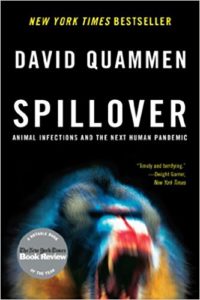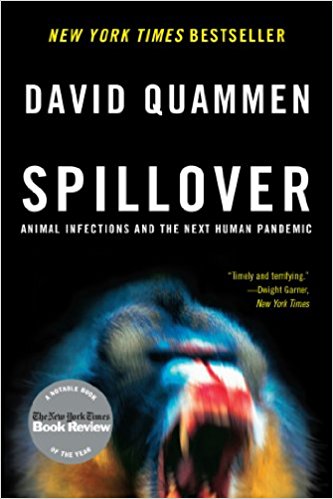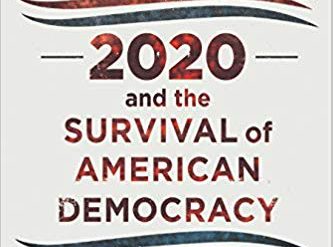
AIDS, Ebola, Marburg, SARS, H5N1 — every one of the world’s scariest diseases is a “zoonosis,” that is, a virus harbored by animals and transmitted to humans, often by other animals, in a complex minuet that often stretches out into decades. And these are the emerging diseases we’ve come to fear the most.
Estimated reading time: 4 minutes
AIDS, for example. According to the latest research, reported by David Quammen in Spillover, Patient Zero was not that French-Canadian flight attendant you may have read about who went amok in the 1970s. He was a hunter in Southeast Cameroon around 1908 who killed a chimpanzee and somehow unknowingly allowed the animal’s blood to seep into his own circulatory system, either through a cut or by eating his prey’s raw flesh. This is the what epidemiologists call “spillover.”
At that point, a particularly virulent form of a recently emergent simian virus found a friendly and familiar environment in the hunter’s blood and flourished, becoming what we know today as HIV-1 (the more lethal form of the virus that causes AIDS). Later, the hunter passed along the virus to one or more women through sexual contact, and the disease slowly spread, both by sex and by transmission through reused needles, undetected as anything out of the ordinary, from Cameroon into what is now called the Democratic Republic of the Congo, Uganda, and other sub-Saharan countries, and thence by happenstance to Haiti. It was a Haitian harboring HIV-1 who probably passed it along to that notorious Canadian flight attendant, setting off the epidemic among gay men in North America.
Spillover: Animal Infections and the Next Human Pandemic by David Quammen (2012) 594 pages ★★★★★
In Spillover, Quammen tells tales like these in fascinating detail, relating the stories of the often heroic scientists, physicians, and veterinarians who worked directly with deadly diseases, occasionally at the cost of their own lives. Quammen spent years writing this book. He appears to have read all the relevant scientific literature, attended specialized scientific conferences, and spent long hours tracking down and speaking face-to-face with the people who discovered these diseases, isolated the viruses, first treated the symptoms, and labored for thankless years on end in laboratories around the world to help humanity avert the next pandemic.
You may have read Richard Preston’s best-selling 2001 treatment of the emergence of Ebola in The Hot Zone. If not, I can tell you that I vividly recall the book because it was so dramatic, and so terrifying. No doubt I had nightmares about contracting Ebola. But it turns out, according to Quammen and to the eminent scientists he interviewed, that Preston’s account was sensationalized and highly inaccurate in essential details. For example, he described tears of blood, massive hemorrhages, and melted internal organs, none of which has any basis in fact.
The culprit? Enormous population growth
However, Spillover, in its own way, is no less frightening. Quammen advances the popular theory that what appears to be the accelerating emergence of dangerous new pathogens became inevitable as a result of the enormous population growth of homo sapiens — because humanity has increasingly encroached on animal habitat and come into intimate contact with animals as never before. In discussions with noted biologists, he explores the concept of “breakout,” the explosive growth frequently seen in some animal species that shortly leads to sudden, catastrophic — through disease. He intimates that, with AIDS — or, all too possibly, with the next pandemic — humankind may experience something similar. Despite all the horrific details about AIDS, Ebola, Marburg, and the like, these are the book’s scariest passages.
David Quammen writes about science, nature, and travel — a total of 10 nonfiction books and five novels to date. A former Rhodes Scholar, he was educated at Yale and Oxford.
For related reading
I’ve also reviewed the author’s excellent novel of espionage, The Soul of Viktor Tronko (Digging down deep to find the mole in the CIA).
I’ve reviewed three other books about epidemiology:
- Pandemic: Tracking Contagions from Cholera to Ebola and Beyond by Sonia Shah (The existential threat of contagious disease)
- Pale Rider: The Spanish Flu of 1918 and How It Changed the World by Laura Spinney (Was the Spanish Flu of 1918 a greater disaster than World War II?)
- The Great Influenza: The Story of the Deadliest Pandemic in History by John M. Barry (A brilliant account of the 1918 flu epidemic)
And you can find a list of books on related topics at Books about epidemic disease and the COVID-19 pandemic.
This is one of the books I’ve included in my post, Gaining a global perspective on the world around us.
You might also enjoy Science explained in 10 excellent popular books.
And you can always find my most popular reviews, and the most recent ones, on the Home Page.


























